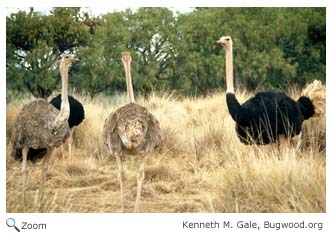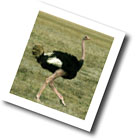 There is one species in this family. It is found in
Sub-Saharan Africa in dry grasslands. There is one species in this family. It is found in
Sub-Saharan Africa in dry grasslands.
The ostrich is the world's largest living bird. It is up to 8 feet tall and weighs as much as 280 pounds. Ostriches have long necks; small heads; and long, powerful legs with two toes. Ostriches can not fly, but they can run at speeds of up to 40 miles per hour. They use their wings to help them keep their balance when they are running. Ostriches use their speed to escape from predators. They also use their powerful legs to kick predators. Males have soft, shaggy black feathers; females have soft, shaggy grayish-brown feathers. Ostriches live in groups of up to 100 individuals, although most groups have around 10 birds. Males mate with 3-5 females, including one dominant female. All of the females lay their large eggs in a group nest. The nest is a scrape on the ground. The male incubates the eggs at night and the dominant female incubates the eggs during the day. A single nest may have as many as 25 eggs. The eggs hatch in around 25 days. The male and the dominant female care for the chicks and protect them from predators. The chick leave their parents when they are about a year old. Ostriches are nomadic and wander for place to place in search of food like leaves, seeds, grasses, roots, insects, and small reptiles and amphibians. World Status Key US Status Key
|
|||||||||||||||||||||||||

